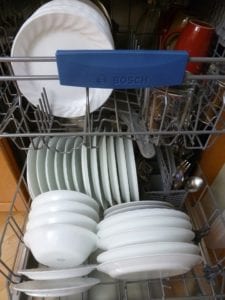 Any home appliances after a certain amount of time will need to be cleaned. Dishwashers are not an exception. In order for the product to work effectively, it is necessary to follow certain rules of operation, as well as to take care of it in a timely manner. Over time, a fairly large amount of dirt can accumulate in the dishwasher, it is not surprising, because every day she has to cope with food particles, fat and other contaminants. All this leads to the appearance of an unpleasant odor, and also promotes the multiplication of bacteria, the occurrence of mold and fungus. Therefore, the question of how to clean the dishwasher, you need to approach with all responsibility.
Any home appliances after a certain amount of time will need to be cleaned. Dishwashers are not an exception. In order for the product to work effectively, it is necessary to follow certain rules of operation, as well as to take care of it in a timely manner. Over time, a fairly large amount of dirt can accumulate in the dishwasher, it is not surprising, because every day she has to cope with food particles, fat and other contaminants. All this leads to the appearance of an unpleasant odor, and also promotes the multiplication of bacteria, the occurrence of mold and fungus. Therefore, the question of how to clean the dishwasher, you need to approach with all responsibility.
At first glance, it may seem that the dishwashing technique does not need care, since it looks clean and attractive for quite a long time. In fact, this is not so. Each wash cycle entails the inevitable contamination and clogging of parts with food and detergent residues, sediment from hard water, etc. All this can lead to a quick breakdown of the device, if it is not taken care of. But timely cleaning of the dishwasher will avoid this problem.
Competent operation
Strange as it may seem, but the more used the dishwasher is, the longer it will be. If it works several times a month, it is likely to clog up and fail quickly. Therefore, it is best to run it at least once every two days. Thus, food remains and other contaminants will not accumulate in the details of the device.
When operating it is necessary to adhere to certain rules:
- It is necessary to regularly check the water inlet hoses and clean them in a timely manner.
- Every two months, you should thoroughly wash and dry the rubber gasket on the door of the machine.
- The number of dishes must comply with the requirements described in the instructions for the dishwasher. In addition, before loading the plate, it is necessary to clean the food residues.
- The dishwasher needs to be washed from time to time. To do this, you need to run it without the dishes, adding a spoonful of heated vinegar to the hot water. After that, wipe the technique dry and dry with the door open.
In addition, you should be aware that some products can not be washed in
dish washer. These include:
- Wooden utensils and cutlery, as this will lead to the loss of their presentation.
- Fragile decorative glass products.
- Collection porcelain and antique dishes.
- Disposable plastic items and cutlery.
- Copper and tin products.
- Stainless steel, crystal with lead particles, dishes with silver and gold inserts.
Also not subject to washing in a dishwasher are products made of synthetic materials, unstable in front of high temperatures, antique antiques and cutlery. This can adversely affect their appearance.
How to get rid of scum and mold?
The most common problems with the operation of the dishwasher are the occurrence of mold and scale inside the device. To eliminate them you can use both special cleaners for dishwashers, and folk recipes, which are not only economical, but also effective.
Scale is easy to remove, using household chemicals designed for this technique. With a special tool, one wash cycle should be started, but the machine must be empty at the same time.
A good result is obtained if you use ordinary baking soda and vinegar to clean the dishwasher. A glass vinegar is poured into the mug and one fourth of a glass of soda is added to it. The container should be placed on the top shelf of the machine and run the device in the usual way, without the other dishes. A qualitative result is guaranteed, and the procedure will have to be repeated no more than once in three months.
Mold is a rather unpleasant phenomenon, which, unfortunately, is not uncommon in places of high humidity. If black spots appear on the walls inside the dishwasher, then a simple means for washing dishes is indispensable here.
To clean the surface of the device, it is necessary to moisten a rag in hydrogen peroxide. Then, rub it with mold stains and the area around them, let the machine stand for two hours. Then treat the fungus accumulation sites. After two to three hours, rinse the machine with warm water.
Picture Credit: NatashaG
